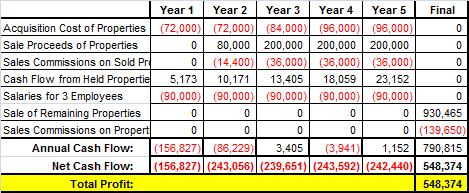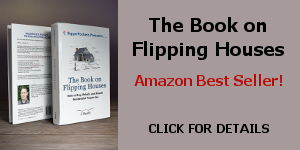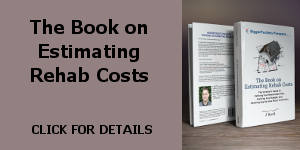In my previous post, I laid the groundwork for completing a pro-forma financial analysis for a potential business focused on buying, rehabbing, and holding/renting single family houses. An earlier post defined a hypothetical, yet realistic scenario for acquiring these properties, and my previous post defined the assumptions around my expected business model, revenue, costs and volume.
Now that we have all this data, we should be able to put together a 5-year pro-forma financial statement for this potential business. While I won’t provide all the financial data that would/will go in the business plan, a simple income statement should suffice to determine whether this plan has economic merit, and to what degree.
If you recall from the previous article, we enumerated all the major income/expense line items that we could expect:
- Acquisition Costs: Expense of $12,000 per property, with expected volume at 6-8 properties per year
- Annual Sale Proceeds: Income of $40,000 per property sold, with expected volume between 2-5 properties per year
- Sales Commission: Expense of $7,200 per property sold
- Cash Flow: $862-$1615 per rented property per year, depending on the length the property has been held
- Salaries: $90,000 per year
- Final Sale of Inventory: Average proceeds of $51,692 minus $7,758 in sales commissions for each of the 18 properties held after 5 years
Combine this with the specific annual volume data provided in the last post:

and it should be fairly straightforward to put together a 5-year pro-forma income and cash flow analysis, as follows:

From this, you should notice a few things:
- Over the 5 years, assuming this model proves accurate, the business should earn about $548K in profit;
- The largest negative net cash flow throughout those 5 years is just over $240K.
Therefore, with a $250K investment into this business, you shouldn’t have to worry about any liquidity issues, the total return you should expect from this business is:

Not too shabby for a first pass; and in addition, there is probably some room for additional upside:
- In the first five years, over $262,000 is spent on realtor commissions; by having one of the company’s employees earn their real estate license, 50% of those fees can be returned to the company. This would add up to another 50% to the total return
- The assumptions used to calculate both future cash flow increases and property value increases are very conservative. As the real estate market picks up again in the next 5 years, both rental rates and property values may increase much more quickly than what is projected in this model
[googmonify]9523523149:center:468:60[/googmonify]




Hi Jason. I think your site and blog are great and I found this analysis to be very informative. I have a question at the end of it all though. If you have each drawn 30K for five years and you split the 548K net profit three ways, you have each only generated about 66K a year. Not bad for a part time endeavor, but not great for a full time gig. If the initial investment and thus the end profit is split two ways between you and your partner the numbers are better but you will never find a contractor to work for 30K a year full time.
Just curious as to how many hours you expect to actually put into a business such as this. Obviously it is an excellent investment of your time and money if you can put up these numbers with 10 or so hours a week.
Interested in how all of this fits into your wealth generating puzzle. Is it a ten% piece or 50% piece.
I have many similar ambitions and hopes of generating wealth through real estate and I really appreciate your insightful and thorough posts. Just trying to dig a little deeper.
Best wishes,
Scott
First, thanks for the nice feedback, Scott…very much appreciate it!
Now, as for your great questions…
The plan here would be that my fiancee and I would get 50% equity in the partnership (and therefore 50% of the profits). The contractor that I mentioned would likely actually be a partner as well, and he is working to raise the other half of the capital. He (and the investors he’s working with) would own the other 50% of the partnership.
So, for each $125K contribution, we would profit about $275K in 5 years (45% return per year). Not a phenomenal return by any means (especially considering it would take a decent amount of time/effort), but certainly not too bad. While I probably wouldn’t undertake this effort if it were the only RE plans I had, it actually dovetails very nicely with my other real estate endeavors, namely the apartment investing. Doing this would help me create more contacts in the industry, help me assemble a strong team, and I imagine our partner in this would be willing to partner in the other activities as well.
Lastly, I’m actually hoping that if we were to pursue this business, we would do it a little bigger than what was laid out here. Would have to adjust the cash flow analysis, but I have some ideas about how we could potentially generate larger income/profits. If we decide to move forward (we’ll likely decide in the next week), I’ll write more about my additional thoughts, and put together further analysis to ensure it will really be worthwhile.
Thanks again!
Sounds about right Jason. And I think your numbers are realistic and conservative, leaving room for potentially more profit from the same amount of work. Look forward to hearing more about it in the future.
Your numbers look very solid and realistic but I cannot find anywhere a very important thing: TAXES!!!
Every house that you sell and you have had it under a year the government will take 50% of your profits because of the short term capital gains tax (just like stocks). And those you sell after owning them for more than one year they will still take 15-25% of your profit.
Is this accounted for in your profits from sales?
PS – awesome blog by the way, keep it up!
Hey Luis,
You bring up a great point. I certainly haven’t forgotten about the issue of taxes, but it’s one of those things that I’ve come to accept as a “necessary evil” when it comes to “flipping” houses.
Certainly, my long-term financial goals need to account for the fact that short-term capital gains will kill me, which I will do by ramping up the number of houses that I hold as rentals (i.e., hold for more than 1 year) as I build my business and my capital reserves.
For example, I’ve considered that for every three houses I buy, I’ll hold one. I’ll be paying short-term gains on 2/3 of my income, and long-term gains on 1/3 of my income. If the income from the 2 houses I sell can cover the purchase of the house I hold, I can repeat this indefinitely, continue to build my cash base, and also build net worth (in the terms of rental properties).
The long-term goal is to then “trade” those rental properties for larger properties (apartments, for example), and live off the cash-flow, which will be completely passive income.
I’ll post more on this in the near future. Thanks for the nice comments, btw!
J
J,
Do you still follow your original business analysis of:
*50% partnership equity to your GC / PM.
*buy and hold 1 out of every 3 homes purchased.
What are some of the new business strategies you’ve implemented since your original analysis?
Thanks in advance.
TF –
I’ve actually deviated from that original plan a good bit. Back then, I didn’t think it would be possible to resell properties nearly as easy as I’ve found it to be. I originally planned to hold many of the properties as rentals for a couple years, and then turn around and sell when the market turned. But, given that I’m not a huge fan of managing rentals and I haven’t had much trouble selling rehabbed properties, I’ve instead just been rehabbing and reselling without the rental step in-between.
Also, I’ve found that I haven’t needed to partner with my contractors. Once I really started to understand the rehab process, it became much easier (and cheaper) to just hire out the work for a fixed price, as opposed to doing a partnership.